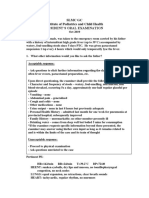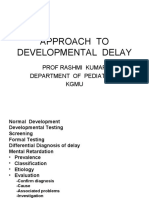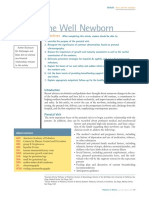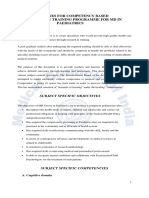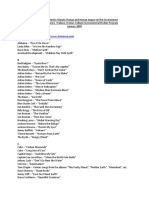Paediatrics at A Glance - Rash 4 Pages Per Page
Paediatrics at A Glance - Rash 4 Pages Per Page
Uploaded by
ColonCopyright:
Available Formats
Paediatrics at A Glance - Rash 4 Pages Per Page
Paediatrics at A Glance - Rash 4 Pages Per Page
Uploaded by
ColonOriginal Description:
Original Title
Copyright
Available Formats
Share this document
Did you find this document useful?
Is this content inappropriate?
Copyright:
Available Formats
Paediatrics at A Glance - Rash 4 Pages Per Page
Paediatrics at A Glance - Rash 4 Pages Per Page
Uploaded by
ColonCopyright:
Available Formats
Skin disorders
134
Part 12 53 Rashestypes of skin lesions
Part 12 Skin disorders
Chapters
Desquamation Maculopapular Vesicles Wheals
53 Rashestypes of skin lesions 134
54 Rashesinfancy and congenital 136
Loss of epidermal cells producing Mixture of macules and papules Raised fluid-filled lesions Raised lesions with a flat top and
scaly eruption Tend to be confluent <0.5 cm in diameter pale centre
55 Rashesinfections and infestations 138 Examples: post scarlet fever, Examples: measles, drug rash Bullae are large vesicles Example: urticaria
56 Rashescommon inflammatory disorders 140 Kawasaki's disease Example: chickenpox
57 Allergy 142
Source: Courtesy of Mollie Miall.
Papules Purpura and petechiae Macules
Solid palpable projections above skin surface Purple lesions caused by small haemorrhages in the skin Flat pink lesions
Example: insect bite Do not fade on pressure Examples: rubella, roseola,
Petechiae are tiny (pinpoint) purpura caf-au-lait spot
Examples: meningococcaemia, ITP, HSP, leukaemia
Source: Courtesy of Dr Katherine Thompson. Source: Courtesy of Mollie Miall.
What you need from your evaluation?
History Physical examination
Is the child ill or febrile? Describe the rash in the following terms:
How long has the rash or skin lesion been present? Raised or flat (papular or macular)
Could it be an insect bite or allergic reaction? Crusty or scaly
Is it a recurrent problem? Colour
Is it itchy? Blanching on application of pressure (the glass test)
Has there been contact with anyone else with a rash? Size of the lesions
Distribution (discrete or generalized, or limited to certain sites
on the body)
I
t is not uncommon for children to present with an unusual rash to approach this problem with a systematic, logical approach.
or for parents to be concerned about skin lesions or birthmarks It is also important to be able to describe the lesions appropriately,
on a childs skin. In some cases, the rash will be acute, due to either when seeking second opinions (e.g. from a dermatologist)
infection, allergy or skin irritation. In other children, the skin or consulting databases and textbooks to establish the diagnosis.
changes may be part of a chronic condition or even a marker for a Following a systematic approach is likely to reveal the diagnosis
neurocutaneous syndrome such as neurofibromatosis or tuberous and prevent the need for requesting further investigations or
sclerosis. In babies, skin lesions may be due to congenital naevi. causing unnecessary anxiety.
While the diagnosis of skin lesions often depends on pattern
recognition and having seen similar lesions before, it is important
Trim size: 213mm x 273mm Miall c54.tex V3 - 03/16/2016 7:02 P.M. Page 136 Trim size: 213mm x 273mm Miall c54.tex V3 - 03/16/2016 7:02 P.M. Page 13
133
136 137
54 Rashesinfancy and congenital Vascular birthmarks
Part 12 Skin disorders
Chapter 54 Rashesinfancy and congenital
Common transient neonatal rashes
Capillary haemangioma Capillary malformation Mongolian blue spot
Very common, especially in preterm infants Sharply circumscribed, pink to purple lesion Blue/grey lesions in the sacral area
Bright red lumpy lesion due to proliferation Present from birth (3 in 1000 births) More common in racial groups with
of blood vessels Abnormal dilatation of normal dermal pigmented skin
Source: Harper, J., Oranje, A. & Prose, N. S. (2006)
Enlarges until age 24 years then regresses capillaries Fade during the early years
Figure 1.4.7, p. 60. Textbook of Pediatric
Dermatology, 2nd edition, Blackwell Publishing,
Usually resolves spontaneously with no May be a sign of SturgeWeber syndrome Can be confused with bruises
Ltd., Oxford.
treatment with an underlying meningeal haemangioma,
Erythema toxicum neonatorum Milia Miliaria* If near important structures (airway, eyes) intracranial calcification and fits
Commonest rash in newborns Very common Occlusion of sweat ducts Oral or topical propranalol treatment can Do not resolve but some lesions may be
shrink down the lesions improved with laser therapy
Small erythematous macules Tiny epidermal cysts More common in hot humid environment
+/ Central small pustules 12 mm white/yellow popular spots Miliaria rubra usually at 1015 days of age
Resolves over a few days Usually on nose, cheeks, chin, forehead Resolves with reduced temperature
Resolve
Pigmentation disorders
Nappy rash Pigmented naevus Caf au lait* Depigmentation
Can be present from May develop Depigmented skin
birth (congenital increasing size and patches seen in
Ammoniacal dermatitis Candidal nappy rash Seborrhoeic nappy rash naevus) or appear number through genetic disorder
during childhood childhood tuberous sclerosis
Erythematous or papulovesicular Bright red rash with clearly Pink, greasy lesions with yellow scale
lesions, fissures and erosions demarcated edge Often in skin folds (moles) Seen in genetic May develop brain
Skin folds spared Satellite lesions beyond border Cradle cap may be present Contains conditions abnormalities,
Caused by irritation from excretions Inguinal folds usually involved Treat with mild topical melanocytes Neurofibromatosis epilepsy, learning
and chemicals May have oral thrush corticosteroids May require surgical McCuneAlbright diculties
Rare with modern disposable nappies (white plaques in mouth) excision if large syndrome Source: Harper, J., Oranje, A. & Prose, N. S. Source: Harper, J., Oranje, A. & Prose, N. S.
Secondary bacterial and candidal Treatment with nystatin If large, at risk Links with (2006) Figure 19.13.2, p.1471.
Textbook of Pediatric Dermatology,
(2006) Figure 19.14.10, p.1496.
Textbook of Pediatric Dermatology,
infection common, and limited use of cream, and orally if of malignant change neurological and 2nd edition, Blackwell Publishing, 2nd edition, Blackwell Publishing,
hydrocortisone and nystatin cream necessary skeletal problems Ltd., Oxford. Ltd., Oxford.
Treat by regular washing and changing,
exposure to air and use of protective
barrier creams .
Psoriatic nappy rash
Appearance similar to seborrhoeic
dermatitis
Family history of psoriasis
138 139
Part 12 Skin disorders
Chapter 55 Rashesinfections and infestations
55 Rashesinfections and infestations
Molluscum contagiosum Tinea corporis (ringworm)
Pearly dome-shaped papules with Dry, scaly papule which spreads
central umbilicus centrifugally with central clearing
Particularly on face, axillae, neck Diagnosis confirmed microscopically
and thighs by scrapings in a potassium
Self-limited disease hydroxide wet mount
Meningococcal septicaemia
Due to molluscipox virus infection Treat with topical antifungal agents
Rapid onset septicaemia +/ meningitis 'Kissing lesions' occur on opposing for 24 weeks
skin surfaces, e.g. under arms and
Commonly due to meningococcus B, or C (other forms on chest
also seen)
Evolves with purple (purpuric) rash that does not
blanch with pressure
Impetigo Cold sore
Severe septicaemic shock, coma and death within hours Sticky, heaped-up, honey-coloured crusts Single or grouped vesicles or
Vaccination for meningococcus C has reduced rate of Group A haemolytic streptococci or staphylococci pustules sited periorally
Immediate treament with antibiotic and fluid Highly infectious Recurrent herpes simplex infection
resuscitation
A new meningococcus B vaccine has been developed and Treat with antibiotics (flucloxacillin or Recur with colds and stress
should be introduced in a new immunisation
erythromycin orally, or antibiotic cream if May be treated with aciclovir
Staphylococcal scalded skin syndrome* schedule in the UK <5 lesions)
Usually triggered by staphylococcal infection
Can cause systemic illness of shock symptoms
Swab skin to confirm infection and sensitivity Scabies Common warts
Treat with intravenous antibiotics and Chickenpox Wheals, papules and vesicles with superimposed eczema Roughened keratotic lesions with
systemic support measures
Very common childhood infection Intensely itchy an irregular surface
Onset 1417 days after exposure Characteristic lesion is the mite burrow between the fingers Occur on hands, face, knees and
Fever then rash (macule, vesicle, crusting) Head, neck, palms and soles are spared in children but not babies elbows
Sometimes see mucosal involvement (mouth, genitalia) Mites can be seen on scrapings Called verrucas if present on feet
Complications of pneumonia, secondary infection, encephalitis Treat all the household with scabicides and launder bedding Transferred by direct contact
Treat symptomatically in healthy children without complications Disappear spontaneously, but can
Immunosuppressed children at risk of severe complications be treated with salicylic acid or
Treat with zoster immune globulin after exposure, and aciclovir liquid nitrogen
if signs of infection develop
Source: Harper, J., Oranje, A. & Prose, N. S. (2006) Figure 5.3.6,
p. 404. Textbook of Pediatric Dermatology, 2nd edition,
Blackwell Publishing, Ltd., Oxford.
Measles
Head lice (pediculosis capitis)
Rare in immunized population (MMR vaccine protects)
Onset 1014 days post exposure Very common in schoolsaects clean hair as well as dirty
Morbilliform rash Itchy scalp
Scarlet fever Cough, fever, conjunctivitis and irritability Nits (the eggs) are visible as white specks on hair shafts
Group A streptococcus tonsillitis Koplik's spots (white spots in mouth) Transmitted on clothing, combs or by direct contact
Erythematous rash, sandpaper-like skin Rare complication of encephalitis Treated by regularly combing out the eggs using an extra fine comb
or the use of anti-pediculosis shampoos. Resistance to these agents
Pale around lips is increasing
Inflamed tongue, strawberry appearance
Risk of sequelae of glomerulonephritis and
rheumatic fever
Treat with penicillin * Courtesy of Prof John Harper. Textbook of Paediatric Dermatology, 2nd Ed, 2005. Blackwell Publishing Ltd.
Rubella Fifth disease
Rare in immunized population (MMR Mild illness with low-grade fever
vaccine protects) Slapped cheek appearance
Onset 1421 days after exposure Lace-like rash on body
Pale morbilliform rash moves down Lasts up to 6 weeks
body Parvovirus B19 infection
Severe fetal anomalies if mother
develops rubella in first trimester
Trim size: 213mm x 273mm Miall c56.tex V3 - 03/16/2016 7:10 P.M. Page 140 Trim size: 213mm x 273mm Miall c57.tex V3 - 03/17/2016 7:31 P.M. Page 14
140 142
56 Rashescommon inflammatory disorders 57 Allergy
Part 12 Skin disorders
Part 12 Skin disorders
Atopic dermatitis (eczema)
Erythema, wet 'weeping' areas, dry scaly, thickened skin The allergic child
Intensely itchy
Risk of secondary bacterial (staphylococcal) and viral (herpes zoster) infection Atopy Allergic conjunctivitis Anaphylaxis
Often linked with other atopic problems, e.g. asthma and hay fever Presents at dierent ages: Itchy, inflamed conjunctivae with tears Rapid onset of severe systemic reaction to
Some cases linked with food and environmental allergens Eczemainfants and preschool Environmental triggers similar to allergic various allergens
Breastfeeding may reduce risk of eczema Food allergytoddlers and preschool rhinitis Specific IgE triggers histamine release from
Treat with moisturizing creams to prevent skin drying Asthmayoung children Treat with topical anti-inflammatory agents mast cells
Cream (water based) to wet areas Hay feverteenagers such as sodium cromoglicate Angioedema and bronchospasm can
Ointment (oil based) to dry areas Aects up to 1/3rd of people at some point drops or topical antihistamines compromise breathing causing hypoxia
Wet wraps to prevent drying and reduce scratching Small proportion develop anaphylaxis Capillary leak can lead to shock
Topical steroids to persistent inflamed areas Usually type I IgE mediated reaction to Triggers:
Topical (tacrolimus) and oral (ciclosporin) immunomodulators if severe common allergens Foods, e.g. peanuts, tree nuts, fish, eggs
Family support and follow-up important for chronic condition Often family history of atopy and milk
Breast-feeding may be protective Insects, e.g. bees, wasps
Seborrhoeic dermatitis Contact dermatitis Parental education and environmental Drugs, e.g. antibiotics
adjustments may be needed Environment, e.g. severe latex allergy
Dry, scaly and erythematous Erythema and weeping
Cradle cap in infancy Itching Treatment with antihistamine, steroid and
intramuscular adrenaline
Aects face, neck, axillae Caused by irritants such as Asthma (see Chapter 29)
and nappy area saliva, detergents and Increasing prevalenceup to 11% children
Treat with synthetic shoes Recurrent bronchospasm Eczema (see Chapter 56)
olive oil and brushing Looks like atopic dermatitis Cough and wheeze Atopic dermatitis
or antifungal shampoo Can be life threateningstatus asthmaticus Common in infancyextensor surfaces
May look like psoriasis Environmental triggerstriggers, e.g. house Localizes to flexoral creases in older children
dust mite Hay fever (allergic rhinitis) May be triggered by diet (e.g. cows milk
Requires bronchodilators 1015% of population protein allergy) or environmental exposure
Psoriasis HenochSchnlein purpura (e.g. detergents)
Erythematous plaques Commonly presents in adolescence Treat with emollients and topical steroids
Vasculitic illness of uncertain Due to environmental triggers such as
Food intolerance
Silver/white scales aetiology, often follows viral illness Non-allergic aetiology grass and tree pollens (most common in the
Extensor surfacesscalp, knees, Purpuric rash to buttocks and legs May be due to enzyme deficiency (e.g. lactase summer months) or house dust mite Contact dermatitis
elbows +/ Arthritis deficiency leading to lactose intolerance) (all year round) Type IV reaction
Guttate psoriasislinked to +/ Abdominal pain with Sensitivity to food additives, Sneezing, rhinitis, nasal congestion and Contact with nickel in cheap jewellery
streptococcal tonsillitis gastrointestinal vasculitis, risk
(antibiotic may improve skin) of intussusception
e.g. monosodium glutamate sinusitis Photosensitivity rashes may be triggered
Presents with colicky abdominal pain and May develop nasal polyps by contact with certain plants
Pitting of nail bed +/ Nephritis (haematuria, proteinuria, diarrhoea Treat with antihistamines and topical Skin patch testing may be helpful in
Guttate psoriasismultiple hypertension) rarely renal failure
Treat by food avoidance corticosteroid identifying cause
tiny psoriatic plaques over large area of body Some evidence steroid helpful if
Treat with topical vitamin D analogues (calcipotriol), coal tar abdominal pain severe
What you need from your evaluation?
Investigations
Acne* Kawasaki disease* History
Very common at puberty Acute inflammatory systemic disorder Check for specific IgE antibodies to suspected
Linked to androgen hormones Many features of infectious illness Is there a family history of atopy (hay fever, eczema or asthma)? allergens, e.g. tree pollen, peanut, milk, egg, house dust
Pustular erythema to face, Fever > 5 days Did the child have eczema during infancy? mite
scalp and trunk Macular erythematous rash Is there an obvious environmental trigger? Skin prick testing may be helpful in contact dermatitis
Treat with antibiotic Peeling skin typically at fingers and Take a full dietary historykeeping an allergy diary may help identify the cause but has poor specificitya positive test may indicate
erythromycin or tetracyclines toes What allergen avoidance has been tried so far? sensitization but does not necessarily correlate with
(over age 12) Lymphadenopathy Ask about drugsis there a history of drug allergy? symptoms
Hormonal treatment with Mucosal changes (cracked lips, What treatments have been needed in the past?previous need for adrenaline shows PEFR and lung function tests in asthma, including
antiandrogen sometimes used strawberry tongue) the allergy may be life threatening reversibility test after bronchodilator treatment
Isotretinoin for severe cases under dermatology Conjunctivitis How much is the childs daily life aected by their allergies? Controlled allergen challengea carefully controlled
Risk of coronary artery aneurysms exposure to increasing quantities of allergen to test
Treat with immunoglobulin and aspirin Examination
Urticaria (see Chapter 57) whether allergy has persisted after a period of
Airway: is there any evidence of stridor or significant angioedema of the lips exclusion. Must be undertaken with care, and with
or tongue? Is there nasal congestion or polyps? facilities for emergency treatment of anaphylaxis
Breathing: observe for signs of respiratory distress and check for wheeze. if there has been a previous severe reaction
Beware the silent chest of severe status asthmaticus
Circulation: check capillary refill for evidence of shock. Blood pressure should be Treatment
measured, but hypotension is a very late sign Avoidance of allergens
Skin: check for urticaria (wheals), excoriation and vesicles of eczema. Antihistamines
Lichenification suggests chronic severe eczema Steroids (topical or systemic)
Adrenaline (for anaphylaxis)
You might also like
- Ankit Yadavendra - Solved Papers Pediatrics For PG Students 3EDocument1 pageAnkit Yadavendra - Solved Papers Pediatrics For PG Students 3ENalayak PopatNo ratings yet
- Oral Exam QuestionsDocument44 pagesOral Exam Questionseiheme22No ratings yet
- Recommended BooksDocument2 pagesRecommended BooksVijayakanth VijayakumarNo ratings yet
- SLMC GC Ipch Osoe (Age) Oct 2019Document4 pagesSLMC GC Ipch Osoe (Age) Oct 2019Alvin FlorentinoNo ratings yet
- Calculations BracketDocument62 pagesCalculations BracketRoshan HegdeNo ratings yet
- Shanz - PEDIA II 2.01 NEWDocument8 pagesShanz - PEDIA II 2.01 NEWPetrina XuNo ratings yet
- Clinical Protocol in Pediatrics, 2012Document96 pagesClinical Protocol in Pediatrics, 2012floare de colt100% (1)
- CH 008 Enteric Fever PDFDocument7 pagesCH 008 Enteric Fever PDFVibojaxNo ratings yet
- Spotters in PediatricsDocument268 pagesSpotters in PediatricsSukla SarmaNo ratings yet
- PaediatricDocument423 pagesPaediatricmuntaserNo ratings yet
- Infant and Young Child Feeding: Dr. Malik Shahnawaz AhmedDocument71 pagesInfant and Young Child Feeding: Dr. Malik Shahnawaz AhmedRiyaz AhamedNo ratings yet
- The Critically Ill Child Pediatrics 2018 - PDFDocument17 pagesThe Critically Ill Child Pediatrics 2018 - PDFgtsantosNo ratings yet
- 01.15.01 Pediatric History Taking and Physical ExamDocument14 pages01.15.01 Pediatric History Taking and Physical ExamMikmik DG100% (1)
- TocOSCE PediatricsDocument14 pagesTocOSCE Pediatricssamy22722100% (1)
- Approach To Developmental Delay: Prof Rashmi Kumar Department of Pediatrics KgmuDocument35 pagesApproach To Developmental Delay: Prof Rashmi Kumar Department of Pediatrics KgmuRishu BujjuNo ratings yet
- Care of The Well NewbornDocument10 pagesCare of The Well NewbornAntonio ValleNo ratings yet
- Pediatric Vital Signs Reference Chart PedsCasesDocument1 pagePediatric Vital Signs Reference Chart PedsCasesAghnia NafilaNo ratings yet
- HAB Manual 2019Document189 pagesHAB Manual 2019anne claire feudo100% (1)
- Pediatric Physical AssessmentDocument99 pagesPediatric Physical AssessmentDuquez Children's HospitalNo ratings yet
- Scenarios For MRCPCHDocument11 pagesScenarios For MRCPCHsayedm100% (1)
- Approach To Chronic Diarrhea in Children - 6 Months in Resource-Rich Countries - UpToDateDocument15 pagesApproach To Chronic Diarrhea in Children - 6 Months in Resource-Rich Countries - UpToDateNedelcu MirunaNo ratings yet
- Counselling On G6PD DeficiencyDocument15 pagesCounselling On G6PD DeficiencyAngelyn BombaseNo ratings yet
- CH 097 Approach To Short StatureDocument8 pagesCH 097 Approach To Short Staturemodi anujNo ratings yet
- Inflammatory: Bowel DiseaseDocument14 pagesInflammatory: Bowel Diseaseusmani_nida1No ratings yet
- Pediatrics A Competency Based CompanionDocument6 pagesPediatrics A Competency Based CompanionNabihah BarirNo ratings yet
- 2022 NMC DM NeonatologyDocument30 pages2022 NMC DM NeonatologySutirtha RoyNo ratings yet
- Pediatric Histotry FormatDocument4 pagesPediatric Histotry FormatJtdbothyNo ratings yet
- Neutrion - PREP 2024Document17 pagesNeutrion - PREP 2024Mohammad BinhamdoonNo ratings yet
- AAA - Nelsons 20th Summary Part 1Document79 pagesAAA - Nelsons 20th Summary Part 1Jessica MarianoNo ratings yet
- Pediatric Community-Acquired Pneumonia: Updated Guidelines Pediatric Community-Acquired Pneumonia: Updated GuidelinesDocument18 pagesPediatric Community-Acquired Pneumonia: Updated Guidelines Pediatric Community-Acquired Pneumonia: Updated GuidelinesugascribNo ratings yet
- AAA - Nelsons 20th Summary Part 2Document122 pagesAAA - Nelsons 20th Summary Part 2Jessica MarianoNo ratings yet
- Practical Medical MicrobiologyDocument12 pagesPractical Medical MicrobiologyAli RazaNo ratings yet
- Pediatric TB Guidelines 2022Document132 pagesPediatric TB Guidelines 2022DYMSNo ratings yet
- TB CPG (PPS)Document28 pagesTB CPG (PPS)Chandice CuaNo ratings yet
- Guide To Paediatric Clinical Examination (24 PGS)Document24 pagesGuide To Paediatric Clinical Examination (24 PGS)Shre RanjithamNo ratings yet
- Antihistamine in Pediatrics AllergyDocument10 pagesAntihistamine in Pediatrics AllergyIndra AdjuddinNo ratings yet
- DNB Pediatrics, CurriuculumDocument44 pagesDNB Pediatrics, Curriuculumbalasubramanian iyer100% (1)
- 2 Year Old / M: What Is Your Diagnosis?Document31 pages2 Year Old / M: What Is Your Diagnosis?Mobin Ur Rehman Khan100% (1)
- DNB Paediatrics Question PaperDocument37 pagesDNB Paediatrics Question Papermrs raam100% (2)
- Kibreet Notes in Pediatrics ADocument69 pagesKibreet Notes in Pediatrics Aisra.burhan18No ratings yet
- Common Newborn Problems (2) C1Document39 pagesCommon Newborn Problems (2) C1ZmNo ratings yet
- Febrile ChildDocument43 pagesFebrile Childdagnenegash19100% (1)
- 07 Pediatrics in Review July20 PDFDocument66 pages07 Pediatrics in Review July20 PDFAndrea PederziniNo ratings yet
- CH 059 STG Iron Deficiency AnemiaDocument8 pagesCH 059 STG Iron Deficiency AnemiaRashmi DandriyalNo ratings yet
- Key To Diagnosis in PaediatricsDocument227 pagesKey To Diagnosis in PaediatricsVaishnavi Singh100% (1)
- Elsharnoby Pediatric Made Easy Up Load Waheed Tantawy 2014Document160 pagesElsharnoby Pediatric Made Easy Up Load Waheed Tantawy 2014hamadadodo5No ratings yet
- Pediatric GastroenterologyDocument26 pagesPediatric Gastroenterologysenthiljayanthi100% (1)
- CH 012 HypothyroidismDocument6 pagesCH 012 HypothyroidismMohan PrasadNo ratings yet
- Guidelines For Competency Based Postgraduate Training Programme For MD in PaediatricsDocument18 pagesGuidelines For Competency Based Postgraduate Training Programme For MD in PaediatricsMohammed ameen mohammed AljabriNo ratings yet
- General PediatricsDocument21 pagesGeneral PediatricsShanmugam Balasubramaniam100% (2)
- Sepsis Management of Neonates With Suspected or Proven Early-Onset BacterialDocument12 pagesSepsis Management of Neonates With Suspected or Proven Early-Onset BacterialAldo CancellaraNo ratings yet
- Neonatal Presentations of Metabolic DisordersDocument16 pagesNeonatal Presentations of Metabolic DisordersyuriescaidaNo ratings yet
- Elsharnoby Pediatric Made Easy Up Load Waheed Tantawy 2014Document160 pagesElsharnoby Pediatric Made Easy Up Load Waheed Tantawy 2014Emad AdelNo ratings yet
- Pediatric DosesDocument17 pagesPediatric DosesIris MambuayNo ratings yet
- Manual of Newborn NursingDocument28 pagesManual of Newborn NursingdocsaravananNo ratings yet
- NICU Feeding GuidelineDocument4 pagesNICU Feeding Guidelinefadhlialbani100% (1)
- 2016 Resident's Pediatric Rheumatology GuideDocument108 pages2016 Resident's Pediatric Rheumatology GuideReba John100% (1)
- Congestive - Cardiac-FailureDocument38 pagesCongestive - Cardiac-FailureAkhil R KrishnanNo ratings yet
- With Notes From The Lecture. If Anything, Just Refer To The Book.Document8 pagesWith Notes From The Lecture. If Anything, Just Refer To The Book.Mao Gallardo100% (2)
- The Ideal Neutropenic Diet Cookbook; The Super Diet Guide To Replenish Overall Health For A Vibrant Lifestyle With Nourishing RecipesFrom EverandThe Ideal Neutropenic Diet Cookbook; The Super Diet Guide To Replenish Overall Health For A Vibrant Lifestyle With Nourishing RecipesNo ratings yet
- Build The Best LegsDocument31 pagesBuild The Best LegsShatha YamaniNo ratings yet
- Mek4450 Marine Operations ExercisesDocument13 pagesMek4450 Marine Operations ExercisesdsrfgNo ratings yet
- Glenmark ReportDocument3 pagesGlenmark ReportBKSNo ratings yet
- Cyber Security AIM Objective: Elective L T P C 3 0 0 3Document4 pagesCyber Security AIM Objective: Elective L T P C 3 0 0 3V.g.MohanBabuNo ratings yet
- Https en Wikipedia Org Wiki SamsungDocument23 pagesHttps en Wikipedia Org Wiki Samsungvomawew647No ratings yet
- Climatechangesongs PDFDocument9 pagesClimatechangesongs PDFkatnavNo ratings yet
- Raini Industries India Private Limited: Mba Summer InternshipDocument10 pagesRaini Industries India Private Limited: Mba Summer InternshipjijiNo ratings yet
- Research Article An Improved Covid-19 Detection Using Gan-Based Data Augmentation and Novel Qunet-Based ClassificationDocument9 pagesResearch Article An Improved Covid-19 Detection Using Gan-Based Data Augmentation and Novel Qunet-Based ClassificationNaoual NassiriNo ratings yet
- An Inverse Problem of Parameter Estimation For Heat and Mass Transfer in Capillary Porous MediaDocument12 pagesAn Inverse Problem of Parameter Estimation For Heat and Mass Transfer in Capillary Porous MediaOkta Darma SaputraNo ratings yet
- Adaptation Lesson PlanDocument32 pagesAdaptation Lesson PlanCrystal PennypackerNo ratings yet
- Balcanica: Institute For Balkan StudiesDocument21 pagesBalcanica: Institute For Balkan StudiesGajevic SlavenNo ratings yet
- Lord of The Flies (Symbolism)Document2 pagesLord of The Flies (Symbolism)zaminmuhammad100No ratings yet
- Full Managing Myositis: A Practical Guide Rohit Aggarwal PDF All ChaptersDocument52 pagesFull Managing Myositis: A Practical Guide Rohit Aggarwal PDF All Chaptersigbokhama100% (3)
- Across-Pro CompressDocument60 pagesAcross-Pro CompressJavier Arancibia MartinezNo ratings yet
- 6.5 Effective Rainfall: Hyetograph of Rainfall Excess or Supra RainfallDocument11 pages6.5 Effective Rainfall: Hyetograph of Rainfall Excess or Supra RainfallAlamgir KhalilNo ratings yet
- WT198CDocument2 pagesWT198CaaquilNo ratings yet
- Surface Sizing BasicsDocument4 pagesSurface Sizing BasicsPeter de Clerck100% (1)
- Process Thermodynamic Steam Trap PDFDocument9 pagesProcess Thermodynamic Steam Trap PDFhirenkumar patelNo ratings yet
- Jeenspsu21 PDFDocument13 pagesJeenspsu21 PDFShweta YadavNo ratings yet
- Agriculture & Nutrition Grade 8 Term-IIIDocument12 pagesAgriculture & Nutrition Grade 8 Term-IIIodoyocollince2002No ratings yet
- Gravity TrainDocument6 pagesGravity TrainRafael Gómez MedinaNo ratings yet
- An Analysis and Evaluation of Kumpfer's Resilience FrameworkDocument13 pagesAn Analysis and Evaluation of Kumpfer's Resilience FrameworkChristian ObandoNo ratings yet
- Bramfitt BL Marder AR Metal Trans 1973 4 2291 PDFDocument11 pagesBramfitt BL Marder AR Metal Trans 1973 4 2291 PDFPablo CollantesNo ratings yet
- Wide Band AntennasDocument8 pagesWide Band AntennasDmk ChaitanyaNo ratings yet
- ABHI Active OneDocument2 pagesABHI Active Onedevayani.inNo ratings yet
- 129 Poojasharma 190-195Document6 pages129 Poojasharma 190-195Nitesh kumarNo ratings yet
- Amity Institute of Environmental Sciences: B. Tech. Semester I Environmental StudiesDocument22 pagesAmity Institute of Environmental Sciences: B. Tech. Semester I Environmental StudiesefjwfdfefefefffefNo ratings yet
- Samikshamag4 PDFDocument53 pagesSamikshamag4 PDFsubiNo ratings yet
- Baf 0 10v Module Install GuideDocument20 pagesBaf 0 10v Module Install Guideestebanvilla1986No ratings yet



